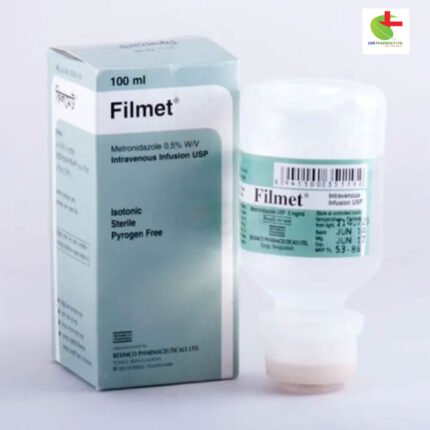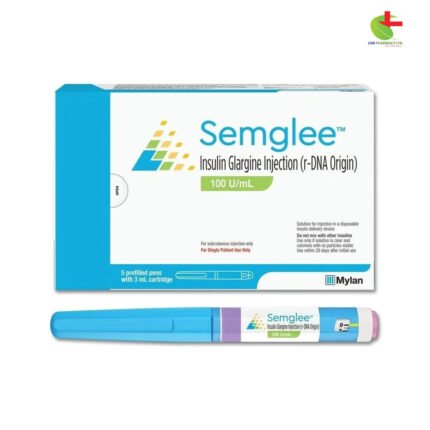Semglee Pen
1,016.00৳ Pcs
- Semglee (Insulin Glargine) is a long-acting insulin for managing blood sugar levels in type 1 and type 2 diabetes.
- Administered subcutaneously once daily, it provides consistent glucose control with up to a 24-hour duration.
- Regulates glucose metabolism by enhancing uptake in muscles and fat while inhibiting liver glucose production.
- Proper dosing and regular blood glucose monitoring are essential for effective management.
 Brand
Brand
|
Beximco Pharmaceuticals Ltd |
|---|---|
 Generics
Generics
|
Insulin Glargine |
 Type
Type
|
SC Injection |
Indications
Semglee is prescribed to help manage blood sugar levels in both adults and children with type 1 diabetes mellitus, as well as adults with type 2 diabetes mellitus.
Pharmacology
Semglee contains Insulin Glargine, a sterile insulin glargine solution intended for subcutaneous injection. This recombinant human insulin analogue is a long-acting agent with up to a 24-hour duration of action, crafted through recombinant DNA technology. Insulin Glargine primarily regulates glucose metabolism by promoting glucose uptake in skeletal muscle and fat, while inhibiting glucose production in the liver. It also suppresses lipolysis and proteolysis, enhancing protein synthesis.
Dosage
Insulin Glargine provides a consistent glucose-lowering effect for up to 24 hours, allowing for once-daily administration. It is equally potent as human insulin. For optimal results, Insulin Glargine should be administered subcutaneously once daily, ideally at the same time each day. Dosing should be personalized based on individual clinical response, with regular blood glucose monitoring being essential. For type 1 diabetes patients, Insulin Glargine must be used alongside short-acting insulin. It is not suitable for intravenous use, as this could lead to severe hypoglycemia.
Starting Insulin Glargine Therapy
- Type 1 Diabetes: Begin with approximately one-third of the total daily insulin requirement, supplementing with short-acting, premeal insulin for the remainder.
- Type 2 Diabetes: Initiate with 10 units (or 0.2 Units/kg) once daily, adjusting as necessary to meet individual needs.
Transitioning to Insulin Glargine from Other Insulin Regimens
- From Once-Daily NPH Insulin: Start with the same dose of Insulin Glargine as the discontinued NPH insulin.
- From Twice-Daily NPH Insulin: Use 80% of the total NPH dose being replaced.
Always follow your healthcare provider’s advice.
Administration
Cartridge:
- Insert the Insulin Glargine cartridge into the pen and attach the needle.
- Gently invert the pen 8-10 times to ensure uniform mixing.
- Set the correct dosage, remove the needle cap, and expel any air bubbles before injecting. Avoid cross-contamination by keeping the needle clean.
Vial:
- Wash your hands and gently shake or rotate the vial to mix the solution.
- If using a new vial, remove the cap and clean the rubber stopper with an alcohol swab.
- Draw air into the syringe equal to the insulin dose needed, then insert the needle into the vial and inject the air.
- Withdraw the required amount of insulin, expelling any bubbles before administering.
Injection Site: Select less tight areas of the skin such as the upper arm, thigh, buttock, or abdomen. Ensure each injection site is at least 1 cm away from previous sites.
Injection Method: Cleanse the skin with alcohol. Insert the needle at a 45° angle and inject the insulin. Remove the needle and apply gentle pressure to the site; avoid rubbing.
Always follow your healthcare provider’s advice.
Interaction
Various medications can influence glucose metabolism, necessitating potential dose adjustments. Substances that may decrease Insulin Glargine requirements include oral anti-diabetic drugs, ACE inhibitors, and certain other medications. Conversely, substances like thiazides and glucocorticoids may increase insulin requirements. Beta-blockers and other drugs may either amplify or diminish insulin’s effects.
Contraindications
Insulin Glargine is not suitable for individuals with known hypersensitivity to insulin glargine or any of its ingredients.
Side Effects
Possible side effects include hypoglycemia, allergic reactions, injection site reactions, lipodystrophy, itching, and rash.
Pregnancy & Lactation
Pregnancy: Insulin Glargine is classified as Pregnancy Category C. It should be used during pregnancy only if the benefits outweigh potential risks. Its presence in breast milk is unknown, so caution is advised for nursing mothers. Adjustments in insulin dosage and diet may be necessary.
Precautions & Warnings
Monitor blood glucose levels regularly. Do not dilute or mix Insulin Glargine with other insulins or solutions, and avoid intravenous administration to prevent severe hypoglycemia. Adjust doses in cases of renal or hepatic impairment.
Overdose Effects
An overdose may cause hypoglycemia. Mild cases can be managed with oral carbohydrates, while severe hypoglycemia may require intravenous glucose or glucagon injections. Adjustments in dosage, meals, or exercise may be needed.
Therapeutic Class
Long-Acting Insulin
Storage Conditions
Store Insulin Glargine between 2°C and 8°C in a refrigerator. Do not freeze and protect from light.













Reviews
There are no reviews yet.